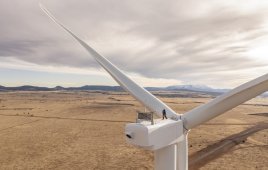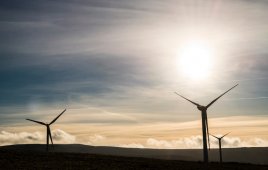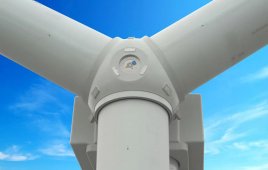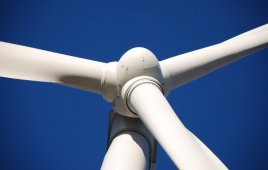Brakes in a wind turbine perform several jobs. They hold blade pitch steady and keep the nacelle pointing in the right direction. Also, that one big disc brake – up to now on the gearbox’s high-speed output shaft to control over over-speed –had better hold everything still when violent storms pass. As OEMs build larger units, over 1.5 MW, braking on the drivetrain is likely to remain a hydraulic function. A thumbnail sketch of trends includes reliable operation, easy service, more complete systems from single suppliers, and overall long-term effort to drive down costs.
Brake manufacturers say operators request smooth, quiet, and reliable braking systems, while O&M crews want easy access to solve maintenance issues. “Low noise from brakes is another trend,” says Colm Gallagher of Carlisle Brake & Friction. “In terms of service, caliper brakes with retractable thrust plates make linings easy to replace.”
To drive costs out of brakes, many companies are working more efficiently –more lean. “The trend in our company, for instance, is to focus on lean manufacturing and lean business processes through a company-wide program,” says Gallagher. “Performance measurements are taken on a daily basis, from the company CEO to machine operators. The system helps drive costs out of business and ensures that purchasing companies receive best possible motion control solutions.”
One research trend is to better understand the nature of friction. Gallagher says caliper brakes are working in the wind market–along with mining, construction, military, and agriculture–so it’s important to understand the “brains” behind effective braking systems–the friction. To that end, his company has purchased others with extensive R&D facilities that focus on brakes and friction.
For electric pitch drives, brakes have trended toward high-torque, electrically released, spring engaged, static holding brakes that can withstand the severe conditions in pitch drives on large turbines. “One pitch brake is rated for 15,000 to 30,000 dynamic stops, depending on coil and voltage required, far exceeding the typical design life criteria of 500 to 1,000 stops,” says Warner Electric’s Engineer Rich Silvestrini.
And where to put the rotor brake is one trend in flux. The rotor brake controls overspeed, and provide parking and emergency braking. These brakes can be mounted on the rotor (low-speed shaft) or on the generator (high-speed shaft), and in some cases on both shafts. Low-speed-shaft braking is relatively straightforward because it is easy to accommodate a large disc brake with a large friction lining area.
The energy to dissipate is the same whether the brake is on the main shaft or the gearbox output shaft–so the total lining area must be the same. But these requirements are more difficult to meet on the high-speed shaft because speed and space will be limiting factors with regard to the maximum disc diameter and brake selections.
The maximum permissible braking torque on the rotor shaft is usually imposed by the blades, or their anchorage to the gearbox input shaft. Also consider that braking on the high-speed shaft is usually related to the maximum permissible gear-tooth loading.
There is also a minimum level of braking torque. Below it, the variable nature of frictional forces from different operating conditions could place the turbine rotors at risk. Nevertheless, braking on the high-speed shaft has been used on many turbines. Although as the industry develops higher capacity turbines, the trend is leaning towards rotor-shaft braking.
One final trend–as old as it sounds–is one-stop shopping. Gallagher, for example, says his company now supplies hydraulic power units along with the brakes it designs so companies need not patch together brake systems from parts purchased from several companies.
WPE
Filed Under: Components, Turbines




